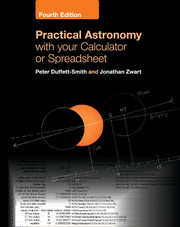Book contents
The planets, comets and binary stars
Published online by Cambridge University Press: 01 June 2011
Summary
An observer looking up at the night sky from the surface of the Earth sees an unchanging pattern of stars revolving slowly about the pole as the Earth spins on its axis. So great are the distances to the stars that the changing position of the Earth as it travels along its orbit around the Sun causes hardly any movement in the pattern, even in the course of six months. There are a few objects, however, which do appear to move a great deal with respect to this fixed background of stars. The objects are members of our Solar System, the planets, the asteroids and the comets. Eight major planets have been identified so far which, in order of increasing distance from the Sun, are Mercury, Venus, Earth, Mars, Jupiter, Saturn, Uranus, and Neptune. (Pluto was originally classified as a planet, but is now considered the largest member of another grouping of objects called the Kuiper belt.) These, together with other members of the Solar System, are all bound by the gravitational field of the Sun so that instead of moving off into space in different directions they are constrained to follow elliptical orbits about it. Their apparent motions in the sky are complicated because they are relatively close to us so that the position of the Earth in its own orbit needs to be taken into account. The next few sections contain methods for calculating the positions, angular sizes, distances, phases and brightnesses of the major planets. There are also sections describing how to calculate the orbit of a comet and the orbit of a binary star.
Information
- Type
- Chapter
- Information
- Practical Astronomy with your Calculator or Spreadsheet , pp. 119 - 160Publisher: Cambridge University PressPrint publication year: 2011
